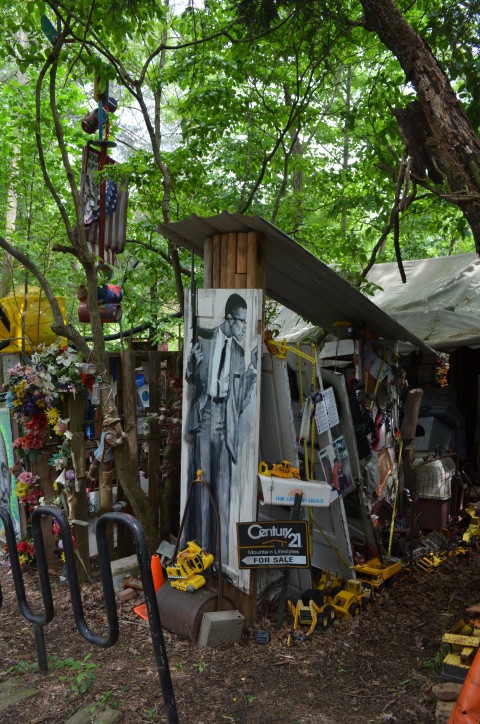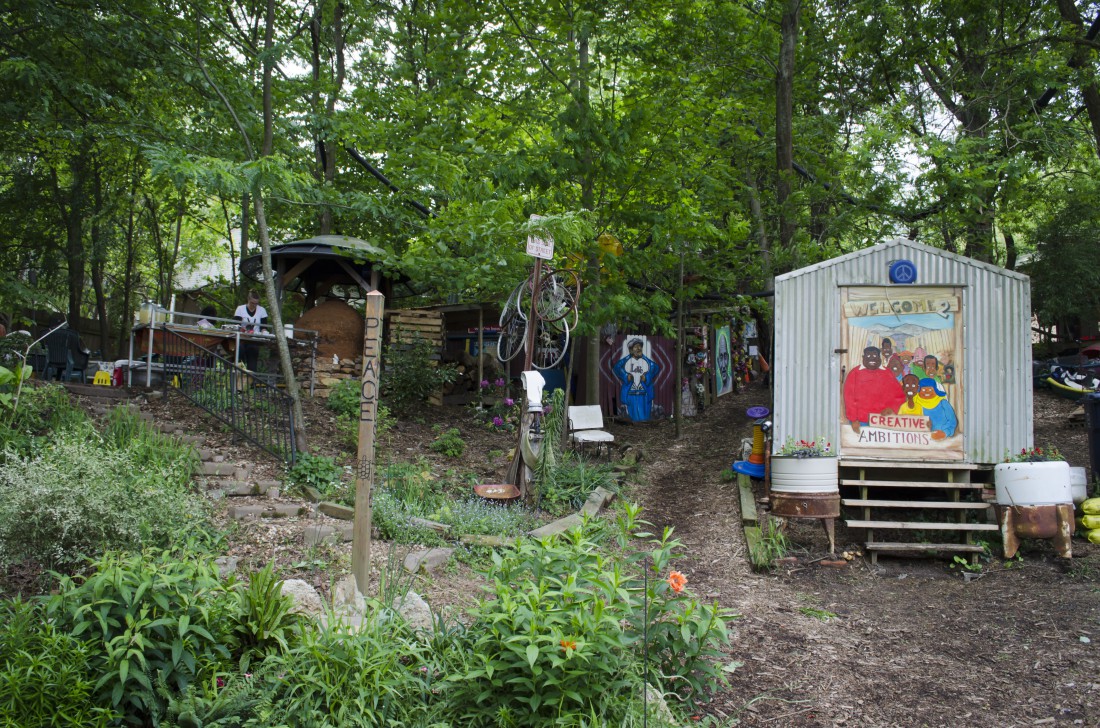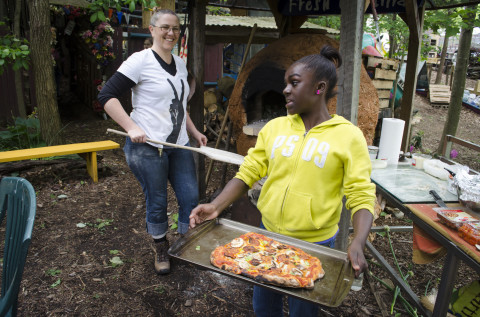If you walk through the Burton Street neighborhood in West Asheville, you’ll find something that looks a little strange — a hillside covered in metal structures, piecemeal art installations made of water jugs, plastic flowers and mannequin limbs, sinuous trails and canopies created desert-island style from salvaged metal.
This is the Burton Street Community Peace Garden, founded by husband and wife DeWayne Barton and Safi Mahaba. Like any community garden, there are tidy rows of vegetables — with kale, lettuce and snow peas, all thriving thanks to this year’s “blackberry winter,” Mahaba notes. But this garden is known for growing something more than food — Mahaba and Barton say their garden works to grow connections in a community with a history of being intersected.

Taking Ownership
“I grew up in a really small, rural community where everybody knew each other, but in the city, you don’t find that as much,” Mahaba says. “Part of that, in this community, was that people didn’t want to be outside much or couldn’t be outside much because there was a lot of drugs and a lot of gun violence.”
Mahaba and Barton moved to Burton Street in 2001. For Barton it was a homecoming — he had lived in the neighborhood until he was 7 years old, and his mother and many other family members lived nearby.
Mahaba, who co-founded the urban agriculture nonprofit Bountiful Cities in 2000, says both she and her husband noticed there weren’t many gardens in the neighborhood. Though they chewed on the idea of starting a community green space, it wasn’t until 2003, after the United States invaded Iraq, that Mahaba and Barton (a Gulf War veteran) began their peace garden, fulfilling a desire to be “a small counterbalance to war.”
In a neighborhood beset with vacant lots, it wasn’t hard to find a spot that could host a garden — though the space that would eventually become the Burton Street Community Peace Garden did not transform overnight.
“It was covered in saplings, one felled tree — and then 40-ounce bottles and liquor bottles,” Mahaba says. “We got enough to fill three 30-gallon trash cans just off a little spot in the front.”
But in the 11 years since Mahaba and Barton began the project, the space has undergone a grand transformation. Today there are two vegetable gardens, as well as Barton’s found-object art installations and a nearly complete canopy covering reading and dining nooks. There are metal statues, colorful murals, a greenhouse, a fire pit, a pizza oven and an outdoor classroom under a pavilion — all of which Mahaba credits to connections made with different individuals and groups in the community, including Green Opportunities (which Barton co-founded), Asheville Design Center and artists from Asheville and the Southeast.
“This space is a green space for the community,” Mahaba says. “People nap by the fire, folks come and take pictures. I see people just hanging out all the time.”
The garden hosts community workdays where neighbors can come and harvest produce. The greenhouse grows plant starts for community members. Barton, Mahaba and their helpers also work to clean up the neighborhood’s sidewalks, removing poison ivy and weeds. And the best part, Mahaba says, is that the garden actively engages the neighborhood’s teenagers.
“We teach them about the plants and how to care for them,” Mahaba explains. “And in the process of doing that, we’re having discussions about how to care for each other.”
An outdoor classroom
Barton agrees that the peace garden’s focus is on working with young people.
“We’re trying to build greater connections with all the schools,” Barton says. “That way, every day when the youth leave the school, there’s still a place in the community that reminds them that their schoolwork is important and can be applied in real life.”
Barton says the primary mission of the garden is to provide a place for training young people. To that end, Barton has cultivated partnerships with local nonprofits just as much as he has cultivated vegetables. This summer, Green Opportunities will use the garden to host a pilot “green jobs” training program, helping teenagers to build skills and competence with tools, giving them an advantage in the job field. Jolene Mechanic will also bring participants in her summertime Concept Camp, held at the Burton Street Community Center, to work in the garden.
Barton says he’s working with a charter school to hold regular classes in the garden’s pavilion, which was constructed in 2011 through a partnership with the Asheville Design Center. He’s hoping to create weather-resistant labels for the many native tree varieties that grow in the space — part of an effort to teach kids about native plant identification — and he’s collecting large alphabet letters to place on the trees as part of a project he’s working on with Hall Fletcher Elementary School’s Read to Succeed program.
“I consider this an outdoor library,” Barton says. “I’ve been collecting the letters to teach kids how to read phonics in an outdoor atmosphere. It’s more engaging and fun when they can work on learning phonics, get up and run around, and then come back and work on their phonics some more.”
Barton and Mahaba also pay the neighborhood teenagers for any work they do in the community or in the garden. Part of that work has included delivering garden produce to neighborhood seniors — something Mahaba says teaches the kids about the history of their families and their community.
“The kids deliver to the elders and, in the process, realize the elders know their moms and dads, aunts and uncles,” Mahaba says. “The neighborhood is historical and multigenerational, three or four generations back — though people might not realize it because they don’t get out and hang out with one another.”
Mahaba says part of the garden’s mission is teaching kids about the history of Burton Street — a community that dates back over 100 years to when E.W. Pearson first purchased and developed the properties that would become a thriving black subdivision, business district and agriculture center, with Pearson’s annual Buncombe District Agriculture Fair drawing crowds nearing 10,000.
“A lot of this is homage,” Mahaba notes. “As we built this garden, we started uncovering pieces of the history of the community. We didn’t know about E.W. Pearson when we started the garden, but then it just felt so right to honor him and that history.”
A focal point
But the Burton Street Peace Garden doesn’t just serve as a testament to the past. It’s a focal point, Mahaba says, for organizing around current community issues, including the potential effects of the N.C. Department of Transportation’s plans for the Interstate 26 corridor, which may require the demolition of many homes in the neighborhood.
Barton, a former president of the Burton Street Community Association, takes the neighborhood’s kids to visit the homes and other sites that would be affected by the current I-26 proposals. He also sends the kids door to door to tell neighbors about community meetings that will discuss I-26 and, with the community association, brought in the Asheville Design Center to develop a community action plan.
I-26 has defined and “hung over the heads” of the Burton Street community for decades, says Chris Joyell, executive director of the Asheville Design Center, the nonprofit founded, in part, to study the state’s alternative designs for the interstate. Joyell attributes many of Burton Street’s struggles — including the vacant lots, crime and social isolation — to being “bisected” by the construction of the highway in the 1960s and the expansion of Patton Avenue in the 1970s.
And yet, “so many people point to Burton Street as an example of a neighborhood that can reinvent itself,” Joyell adds. “And the community itself pointed to that garden as one of the things that demonstrates how the community can rally internally.”
Without the garden, the neighborhood “wouldn’t be the same,” says Gwendolyn Barton, DeWayne’s mother, who has lived on Burton Street for most of her life.
“This place was liquor bottles, drug needles, poison ivy — it was a mess,” Gwendolyn says, noting that the peace garden has inspired the creation of two more gardens in vacant lots in the neighborhood.
“It’s a collaboration,” Gwendolyn explains. “Everyone eats from the garden. It brings people to the community meetings, though I do wish more people would come. With I-26 coming through, we need to be on top of that, for real.”
I-26 will continue to loom over Burton Street as NCDOT finalizes plans for the connector. Joyell says that in a community where many people rely on their neighbors to take them to the grocery store or to the pharmacy, even the loss of a few homes may negatively impact the most vulnerable members of the neighborhood. With the possibility of years of construction or state seizure of homes, relocation may seem like a desirable option for many of Burton Street’s residents. But Joyell says many in the community do not have that liberty, and regardless, he adds, the community’s investment in itself is a sign that the residents don’t want to leave.
“That garden is the centerpiece of that [feeling],” Joyell says. “It was really the first sign that folks intended to stay there, and they weren’t going to turn their backs to the problems of the community or just relocate — despite DOT, despite all the problems that neighborhood once had. It’s a peace garden but it’s also a victory garden.”
The grand vision
When Mahaba and Barton first moved to Burton Street in 2001, the neighborhood was quiet. But now?
“If you listen — you can already start to hear it, you’ll hear them more later in the afternoon or into the evening — but you’ll hear the kids out in the community,” Mahaba says while sitting in the garden’s pavilion. “I think the work we’ve done has contributed to making the place look better, which makes people feel better about their community.”
“The more we’re all out — on the sidewalks, on the street, on our porches, in the garden — the more likely we are to see and create positive activity,” she adds.
Looking to the future, Mahaba says her “grand vision” is to see Burton Street become a vibrant hub of urban agriculture, echoing its past and honoring the legacy of E.W. Pearson.
Barton already has a laundry list of summertime plans for the garden, including adding solar lights, birdhouses, a composting toilet — all little things that the youths can work on to build their confidence in using tools, he notes.
But if the garden’s construction plans are modest, Barton’s vision is not. He and other community members are working to get a solar panel installation and a technology center for the community center, using the savings from the solar panel to fund more community programs. He’s working with LEAF Schools & Streets to install a one-microphone recording studio in the community center to encourage neighborhood musical pursuits. And he’s involved with a community partnership with the Asheville Design Center that aims to create a greenway along Smith Mill Creek, with an entrance about half a mile away from the garden.
For Barton it’s about making the peace garden and the whole Burton Street community a pilot program for “showing things communities can do to make themselves better.”
“We want to encourage other communities to make green spaces like this,” Barton says. “We want it to draw a cross section of people of different ages and races to show how different people from under the same umbrella, the same neighborhood, can come together. Because once you get different people together, then you can start to build better relationships across the board.”
Scroll through the slideshow to see more from the Burton Street Community Garden.
To keep up with the latest updates from the Burton Street Community Peace Garden, visit burtonstreet.org or the garden’s Facebook page.





What a DUMP!!!
BEAUTY IS WHAT BEAUTY SEES!
INSPIRING!!